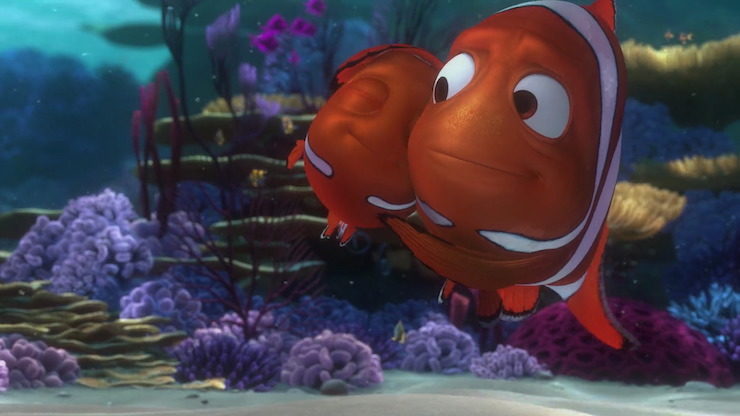“Fish are friends, not food!”
Before we get into this post, I must make a quick confession: of all of the Pixar films, this is probably the one I resent the most. Not because of anything actually in the film, I must say, but because of what has happened to aquaria since the film’s release: Hordes of little children squeaking “NEMO NEMO NEMO LOOK IT’S NEMO” even when the clownfish in question are OBVIOUSLY NOT NEMO SINCE THEIR FINS ARE PERFECTLY FINE SOMETHING YOU MIGHT HAVE NOTICED, KIDS, IF YOU WEREN’T SO BUSY SQUEAKING “NEMO!”
And that’s before we get into what this film did to one of the Epcot rides.
And with that out of my system, onto Finding Nemo.
Pixar’s animators started work on Finding Nemo with considerable confidence. They had produced three films that had been both critical and financial hits, and felt fairly confident that Monsters, Inc. would be their fourth such film. It was also the final film to arise from a 1996 pitch session, where Pixar executives had agreed that their next three films—all contracted to Disney—would be a bug film, a monster film, and a fish film, creating a little internal milestone. This order was later interrupted early in the development process for Toy Story 2, a film shifted from direct-to-video to wide release, but the concept of the fish film remained.
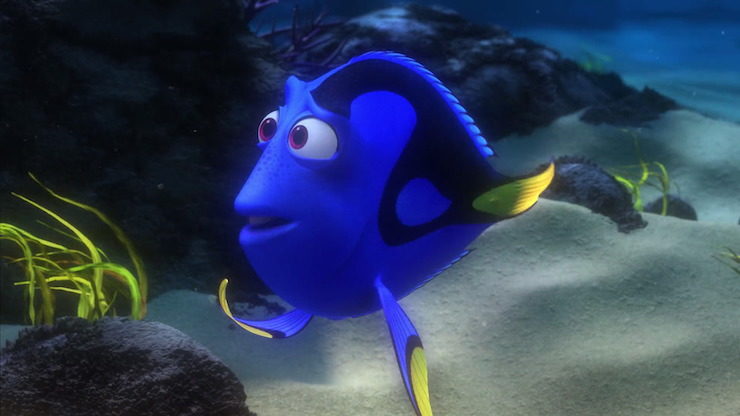
Director and co-writer Andrew Stanton felt particularly excited. He loved tropical fish. He also felt that he could bring two experiences from his own life into the film: visits to a dentist’s office that had a large tank of tropical fish, and a later trip to an aquarium with his young son—a visit where, Stanton later admitted, he’d been a touch bit overprotective, an element that was later used to drive most of Finding Nemo’s plot. And he loved clownfish. He started work on the script, with help from animator Bob Peterson and comedy writer David Reynolds, as others at Pixar were frantically rushing around to finish A Bug’s Life. Since the fish film wasn’t slated to start production for two more films, that meant that Finding Nemo had the luxury of starting with a completed script.
On the other hand, Finding Nemo had been left for last for good reason: the technical challenges facing the film vastly outweighed the earlier challenges of creating realistic fur, multiple bugs, and a full length computer animated film in the first place. For Finding Nemo, animators and engineers had to struggle through a problem that had stumped animators since the 1940 Pinocchio: animating underwater sequences. To this, John Lasseter added a new challenge: eager to show off Pixar’s growing technical skill, he ordered the world of Finding Nemo to look as natural as possible.
To get there, the animators and engineers watched not just Disney animated films, but also various underwater documentaries and Jaws. Pixar hired a fish expert from Berkeley, with the title of lead aquatic consultant, to teach the animators about fish. Not all of his instruction was used—Pixar decided, for instance, that Dory would wiggle her tail while swimming even if regal blue tangs do not actually do this in the wild—but animators used his lectures to create realistic looking fish movements, as well as adding some exotic critters to the reef scenes (for instance, the briefly seen, brightly colored sea slug). Some went scuba diving. Others studied a saltwater tank installed in Pixar’s production facilities for the occasion. A few of them even dissected fish.
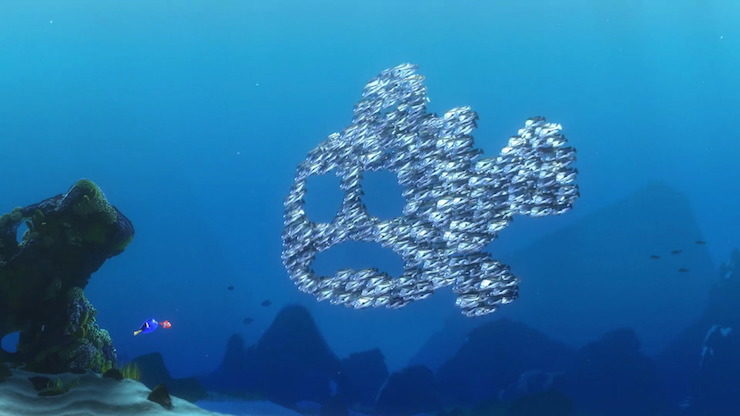
The worst part of animating underwater sequences wasn’t, however, getting the fish right, but adjusting correctly for the way the perception of light changes underwater. The second worst was adjusting for the movement of water, which can distort images—a particularly tricky situation for one of Finding Nemo’s biggest sequences: traveling with the help of sea turtles. The third worst was getting all of the myriad colors and details of coral reefs and their denizens correct. The animators, fortunately, had a new tool at their disposal: Fizt, the program developed to allow the monsters of Monsters, Inc. to have realistic looking fur, now used to make sure that little Nemo had realistic looking water.
The end result provided some amazing shots, including several which beautifully echo the look of sunlight on sands beneath shifting water. It also, in director Andrew Stanton’s opinion, was too realistic—several frames looked exactly like underwater photographs or video, instead of animated sequences. He sent animators and engineers back to their computers to create what Pixar would term hyper-reality—that is, something that looks realistic, but not quite photo realistic.
Stanton divided the animators and engineers into six separate groups to keep production running smoothly, a process that was only briefly interrupted by a visit from Hayao Miyasaki, there to work with John Lasseter on the English version of Spirited Away. The director took the opportunity to tour the Pixar offices (and the toy collections), as well as meet with Andrew Stanton and Brad Bird, to take a look at early bits from Finding Nemo and The Incredibles. Otherwise, everyone stayed bunkered down in the Pixar building to ensure that this film would be released in time, without the same sort of last minute rush that had hampered both Toy Story 2 and Monsters, Inc.
That turned out to be optimistic, but the end result, everyone agreed, was worth it.

Finding Nemo opens by introducing us to habitual worrier Marlin, a small clownfish who has just moved to a brand new beautiful sea anemone right at the edge of a coral reef, overlooking the ocean. It’s an extraordinary view, and Marlin is proud of having secured the spot—if more than a bit worried about whether his wife Coral really likes their new home and whether the 400 or so kids he and Coral are expecting at any minute will like him. Before he can be completely reassured, he and Coral see a shadow off in the water. Coral, seeing those 400 eggs gleaming below, dives down –
Which is about when Pixar mercifully allows Finding Nemo to fade to black for a few seconds.
When colors return, Marlin discovers that he’s all alone except for one shaky little egg.
It’s easily one of the saddest moments in animation since Dumbo—possibly the saddest moment in animation ever. (Not that I sniffled on this most recent viewing, mind you, because I am now a grownup in full control of my emotions. It’s just that I don’t dust as much in this house as I really should. I expect you all understand.)
Fortunately, before anyone can become depressed for life, the film jumps forward in time to when that shaky little egg, now a fish named Nemo, is ready for his first day of school. Something—perhaps the trauma right before his birth, perhaps something else—has left him with a short fin. Marlin believes this makes little Nemo a weak swimmer. Nemo disagrees. The film mostly suggests otherwise.
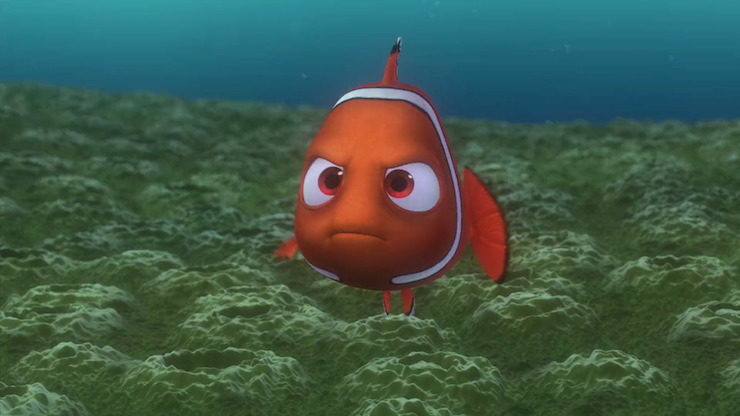
And may I just pause here and note that I love how Finding Nemo handles this. As it turns out, this will be the first of at least three characters with a disability in one form or another: two fish with fin problems, plus one fish with severe mental issues. I say “at least” since I’ve heard a few viewers put the sharks and the very greedy seagulls into the disabled category as well. Two of these fish, Nemo and Dory, were born with their disabilities (the suggestion in Finding Nemo that Dory has always had these memory problems was confirmed in the sequel, Finding Dory). The third, Gill, acquired an injury that never quite healed. All three have to deal with others (primarily but not just Marlin) doubting their abilities. All three openly voice their frustrations. And Nemo gets to voice his frustration not just with his weak fin, but the way his father treats him because of that fin. To be fair, the fact that the rest of their family was brutally eaten has clearly left the already easily spooked Marlin deeply traumatized, but Nemo sees this as his father not letting him do anything and doubting his abilities.
At the end of the film, all three are still disabled, without a magical cure in sight. But all three have either accomplished their main goals, and/or found their places in the ocean (Gill is kinda stuck). And Marlin, after many misswims, has finally learned how to communicate with his son and give the kid the freedom the little fish needs. It’s both an idealized and a remarkably accurate picture not just of disability, but of many of the reactions to disability.
Finding Nemo also plays with and subverts various stereotypes about the various critters of the sea. A small blink or you’ll miss it moment involves a hermit crab and his shell. Jacques the cleaning shrimp cleans (and has to be deliberately told not to clean as part of the plot.) The sea turtles are completely chill, partly because they’re long lived, mostly because they’re turtles.
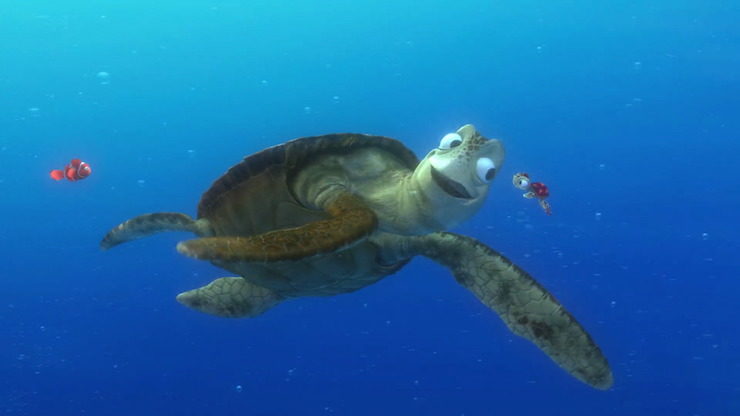
On the other side, Marlin frequently finds himself objecting to stereotypes about his species—”Actually, that’s a common misperception. Clown fish are no more funny than any other fish”—while simultaneously failing to realize that he’s operating under misperceptions of his own son. Three sharks desperately battle their own instincts and the perceptions about them, forming a nice contrast and analogue to Marlin’s assumptions about Nemo, while providing some of the most hilarious bits of the film—thanks in large part to Dory’s enthusiastic embrace of their creed.
Dory, incidentally, was a role both specifically written for and inspired by Ellen DeGeneres, whose monologues often feature her changing her mind multiple times in a single sentence, something Stanton adapted into Dory’s short term memory losses. For the other voice roles, Pixar cast a mix of established comedians, drama actors, Pixar animators (in brief roles), children of Pixar animators (in even briefer roles) and the director himself as the voice of chilled-out Crush the Turtle.
I suspect, though, that for the most part, what most viewers will remember is not the vocal work, excellent as it is, or the jokes, great as the shark sequence is, or even the action sequences, amazing as both the shark chase and the bouncing trip across glowing jellyfish are, but rather the rich relationship between Marlin and his only surviving son, and the spectacular beauty of this film, which to a degree not seen since Fantasia took the time to get everything right, right down to the patterns of shifting sunlight on ocean sands.
Even if this all led to the deeply unfortunate state of contemporary aquaria filled with small children shouting “NEMO NEMO NEMO!”
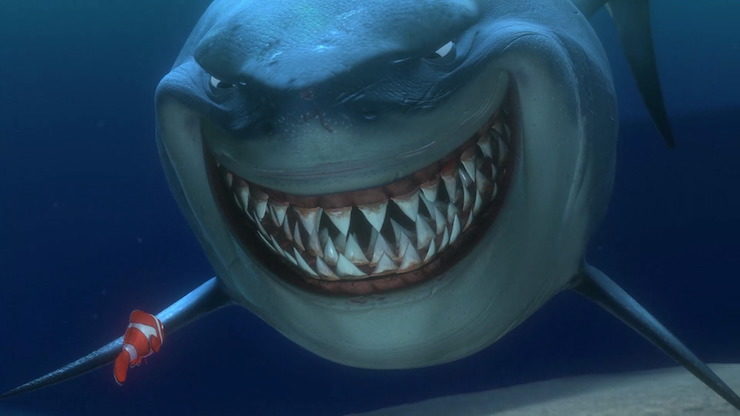
Finding Nemo was a box office smash, with its initial release bringing in $862 million at the box office, a total that in 2003 was beaten only by The Lord of the Rings: Return of the King. A later 3D release in 2012 added $72.1 million to that, for a box office total of $940,335,536 in 2013; Disney continues to release the film for special matinee performances each summer, adding to that total. The film was also a critical success, and took home several awards, including the Academy Award for Best Animated Picture.
On home video, Finding Nemo was even a bigger success, selling a jawdropping 40 million copies. Over a decade later, the film remains one of the most successful animated films of all time, and the DVD/Blu-Ray versions continue to rank in Amazon’s top 1000 sellers.
Even more impressive was the merchandising, which included toys and pillows based on all of the characters (I refuse to sleep with Nemo under my head, but I’ll admit the pillow is cute), mugs (the one featuring the seagulls squawking MINE MINE MINE does sorta sum up my attitude towards coffee in many mornings), clothing, cell phone cases, trading pins, and more.
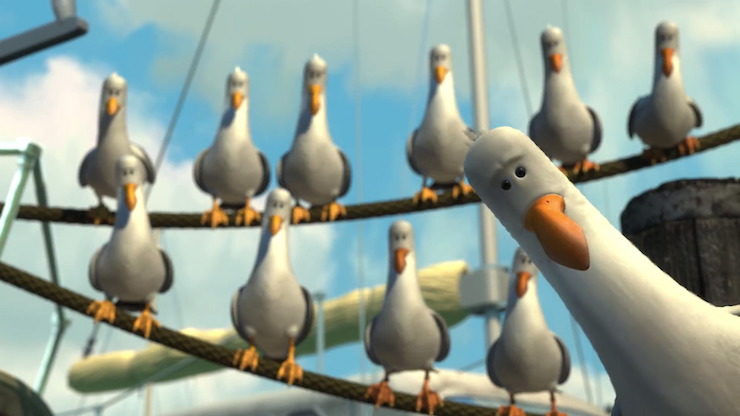
Disney also added various attractions to many of their theme parks, including Turtle Talk with Crush (found at Epcot, Disney’s California Adventure, Hong Kong Disneyland and some of the Disney cruise ships); a roller coaster in Disneyland Paris; a musical at Animal Kingdom; and, in what I still consider a disastrous move, The Seas with Nemo & Friends, which was less a new ride and more Disney projecting images of Nemo, Dory and Martin ON THE GLASS COVERING THE GIANT AQUARIUM, preventing riders from SEEING THE ACTUAL FISH, SHARKS, TURTLES AND DOLPHINS swimming in the huge artificial coral reef that had been a staple of the park since 1986 like THANKS DISNEY. (My current advice is to avoid the ride entirely and just sneak in through the back of the building, allowing you to view the rest of the aquaria and exhibits, including Turtle Talk with Crush.)
Arguably, Finding Nemo had one other disastrous effect: demand for clownfish in tropical saltwater tanks expanded. Clownfish can be bred in tropical tanks, but are cheaper to obtain through fishing, leading several less than sustainable hunts for the cheerfully colorful fish, with methods including releasing cyanide into the water, to stun the fish to make them easy to collect. Other groups collected live coral from reefs to decorate tanks, placing additional stress on already stressed reef areas. Actual numbers are a bit dodgy, but multiple local groups in the Pacific and the Atlantic claimed that both coral reef and numbers of fish declined after “Nemo fishes,” accusing several outside fishing companies of corruption.
In addition, at least some upset small children and families then decided to “free” their little Nemos—either through plumbing systems or directly into oceans—either killing the poor fish in the first instance, or introducing an exotic species into nearby oceanic habitats in the second. The effects have not been conclusively measured (partly because oceanic habitats face enormous stress from numerous points, not just crying children) but may have somewhat contributed to coral reef declines.
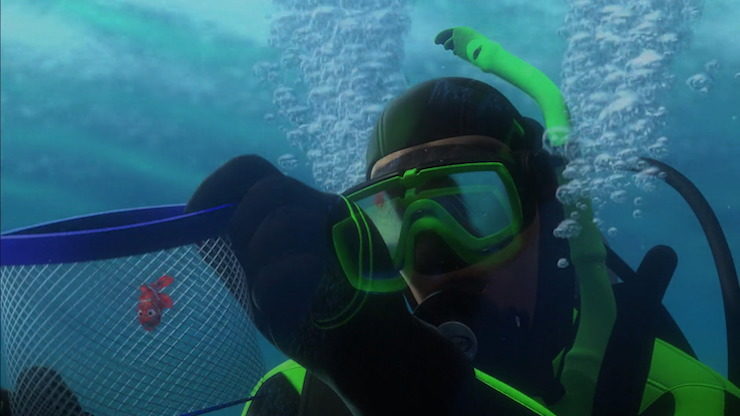
On the other hand, ecological tourism groups in Vanatu noted that interest in their introductory scuba trips skyrocketed after the groups added a slightly inaccurate “Come see Nemo!” to their marketing and advertising. (The clownfish in the waters around Vanatu are a different species.) It seems possible that Finding Nemo inspired at least some small children, and perhaps even a few adults, to learn a little bit more about the oceans and coral reefs, and how to protect them for future clownfish.
Meanwhile, both Disney and Pixar had other concerns—most notably a declining business relationship punctuated by the threats of Steve Jobs to leave Disney and find another distributor. Not surprisingly, their next film would feature a man deeply unhappy with the constraints of his money-focused job.
The Incredibles, coming up next month.
Mari Ness lives in central Florida.










